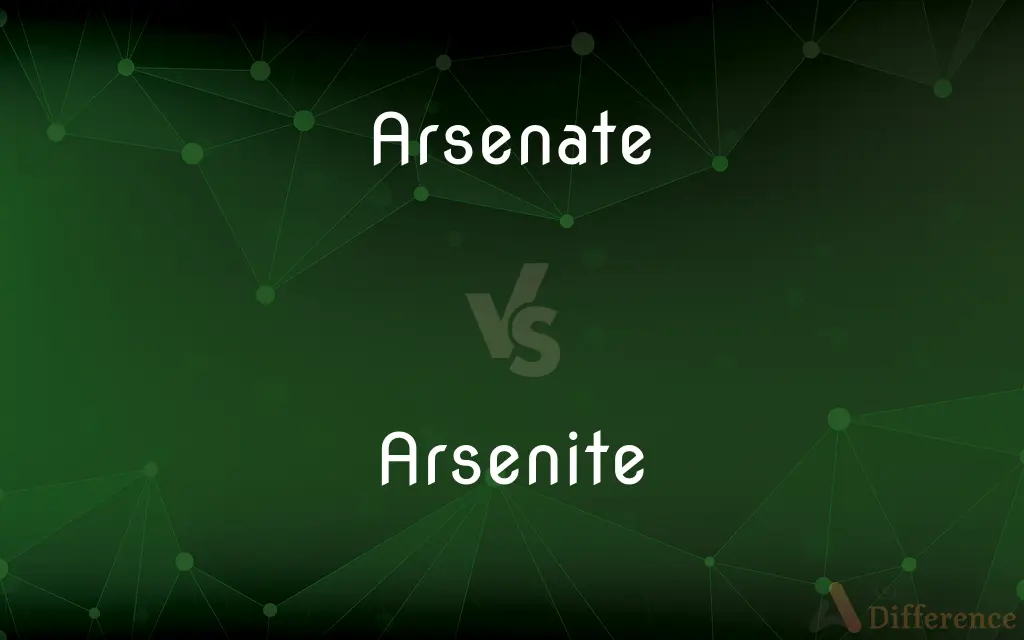Arsenate vs. Arsenite — What's the Difference?
By Tayyaba Rehman & Urooj Arif — Updated on May 3, 2024
Arsenate is a compound containing arsenic in its +5 oxidation state, while arsenite features arsenic in the +3 state, affecting their chemical behavior and toxicity.

Difference Between Arsenate and Arsenite
Table of Contents
ADVERTISEMENT
Key Differences
Arsenate compounds typically exist as anions with the formula AsO4^3-, where the arsenic atom is bonded to four oxygen atoms. On the other hand, arsenite compounds are often found as AsO3^3- anions, where three oxygen atoms are bonded to arsenic.
In terms of chemical stability, arsenates are generally more stable and less reactive compared to arsenites, which tend to be more chemically reactive and can easily form complexes with other substances.
Environmental behavior of arsenates shows them being more prevalent in oxidizing conditions, whereas arsenites are more stable and predominant under reducing conditions.
The toxicity of arsenate is significant but generally considered lower than that of arsenite. Arsenite, by contrast, is more toxic due to its ability to interact more readily with cellular components.
In terms of remediation and treatment, arsenates can be treated and removed from environments using a variety of chemical processes, including oxidation and coagulation, whereas arsenites often require different approaches, such as reduction or more advanced filtration methods.
ADVERTISEMENT
Comparison Chart
Chemical Formula
AsO4^3-
AsO3^3-
Oxidation State of Arsenic
+5
+3
Stability
More stable, less reactive
Less stable, more reactive
Environmental Prevalence
Found in oxidizing conditions
Found in reducing conditions
Toxicity
Generally lower
Generally higher
Compare with Definitions
Arsenate
Typically found in an oxidized state in nature.
In well-oxygenated soils, arsenate is the dominant arsenic species.
Arsenite
A chemical compound in which arsenic has a trivalent form.
Arsenite is more soluble and toxic than arsenate.
Arsenate
Often used in agriculture as a pesticide.
Calcium arsenate helps control pest populations.
Arsenite
Known for higher toxicity in biological systems.
Arsenite can disrupt cellular processes more easily than arsenate.
Arsenate
A chemical compound containing arsenic in its pentavalent form.
Sodium arsenate is used in some industrial processes.
Arsenite
Predominantly found under anaerobic conditions.
In reduced groundwater, arsenite is more commonly found.
Arsenate
Can be a byproduct of arsenic pollution.
Arsenate contamination in groundwater can occur from natural deposits.
Arsenite
Requires specific remediation techniques.
Removing arsenite from water often involves complex filtration methods.
Arsenate
Used historically in wood preservation.
Copper chrome arsenate was employed to treat timber.
Arsenite
Used in past as a herbicide and wood preservative.
Arsenite-based compounds were once popular in agriculture.
Arsenate
The arsenate ion is AsO3−4. An arsenate (compound) is any compound that contains this ion.
Arsenite
In chemistry, an arsenite is a chemical compound containing an arsenic oxoanion where arsenic has oxidation state +3. Note that in fields that commonly deal with groundwater chemistry, arsenite is used generically to identify soluble AsIII anions.
Arsenate
A salt, ester, or anion of arsenic acid.
Arsenite
(chemistry) Any oxyanion of trivalent arsenic, especially the AsO33− anion (or protonated derivatives); any salt containing this anion, or any ester of arsenious acid
Arsenate
(chemistry) Any salt or ester of arsenic acid.
Arsenite
A salt formed by the union of arsenious acid with a base.
Arsenate
(chemistry) The anion AsO43−.
Arsenate
A salt of arsenic acid.
Arsenate
A salt or ester of arsenic acid
Common Curiosities
What are the health effects of exposure to arsenate?
Exposure to arsenate can cause skin lesions, cardiovascular diseases, and an increased risk of cancer, although its effects are generally less severe than those of arsenite.
What are the health risks associated with arsenite exposure?
Arsenite exposure is highly toxic and can lead to severe health issues including skin damage, circulatory system problems, and an increased risk of various cancers.
How do arsenate and arsenite affect drinking water safety?
Both arsenate and arsenite can contaminate drinking water, with arsenite being particularly concerning due to its higher toxicity and mobility in water.
How do arsenate and arsenite enter the environment?
Arsenate can enter the environment through agricultural runoff and industrial emissions, while arsenite may leach from natural mineral deposits or industrial waste.
What role do arsenate and arsenite play in soil chemistry?
Arsenate is generally more stable in soils and can bind to soil particles, whereas arsenite is more mobile and can leach into groundwater.
Can arsenate be converted to arsenite in the environment?
Yes, arsenate can be reduced to arsenite under anaerobic (low oxygen) conditions, such as in waterlogged soils or groundwater.
What are the industrial uses of arsenate and arsenite?
Arsenate has been used in glass production and as a wood preservative, while arsenite has been used in the past for producing pesticides and herbicides.
What are common remediation strategies for soils contaminated with arsenate and arsenite?
Strategies include phytoremediation, chemical stabilization, and excavation, with specific approaches depending on whether arsenate or arsenite is predominant.
Are there any natural processes that mitigate arsenate or arsenite toxicity?
Certain microbial processes can convert these compounds into less harmful forms, such as converting arsenite to arsenate in oxygen-rich environments.
What regulatory standards exist for arsenate and arsenite in water?
Regulatory standards typically address total arsenic concentrations, which include both arsenate and arsenite, due to their combined health risks.
How do treatment methods for arsenate and arsenite in water differ?
While both can be treated by similar methods, arsenite often requires pre-oxidation to convert it into the more easily removable arsenate form.
What are the ecological impacts of arsenate and arsenite pollution?
Both compounds can harm aquatic life and ecosystems; arsenite in particular can have more drastic effects due to its high toxicity.
Can plants absorb arsenate and arsenite, and how does it affect them?
Plants can absorb both forms of arsenic; arsenate can inhibit photosynthesis and growth, while arsenite is more toxic and can cause immediate harm to plant cellular functions.
How does the biological uptake of arsenate differ from arsenite?
Arsenate is typically taken up by plants and animals as a phosphate analog, disrupting metabolic processes, whereas arsenite directly binds to proteins, affecting their function.
How do arsenate and arsenite affect microbial life?
Microbes can metabolize both arsenate and arsenite, but the processes differ; arsenate is often used as an electron acceptor, while arsenite is oxidized to arsenate in microbial detoxification pathways.
Share Your Discovery

Previous Comparison
Canon vs. Priest
Next Comparison
Race vs. RideAuthor Spotlight
Written by
Tayyaba RehmanTayyaba Rehman is a distinguished writer, currently serving as a primary contributor to askdifference.com. As a researcher in semantics and etymology, Tayyaba's passion for the complexity of languages and their distinctions has found a perfect home on the platform. Tayyaba delves into the intricacies of language, distinguishing between commonly confused words and phrases, thereby providing clarity for readers worldwide.
Co-written by
Urooj ArifUrooj is a skilled content writer at Ask Difference, known for her exceptional ability to simplify complex topics into engaging and informative content. With a passion for research and a flair for clear, concise writing, she consistently delivers articles that resonate with our diverse audience.
















































